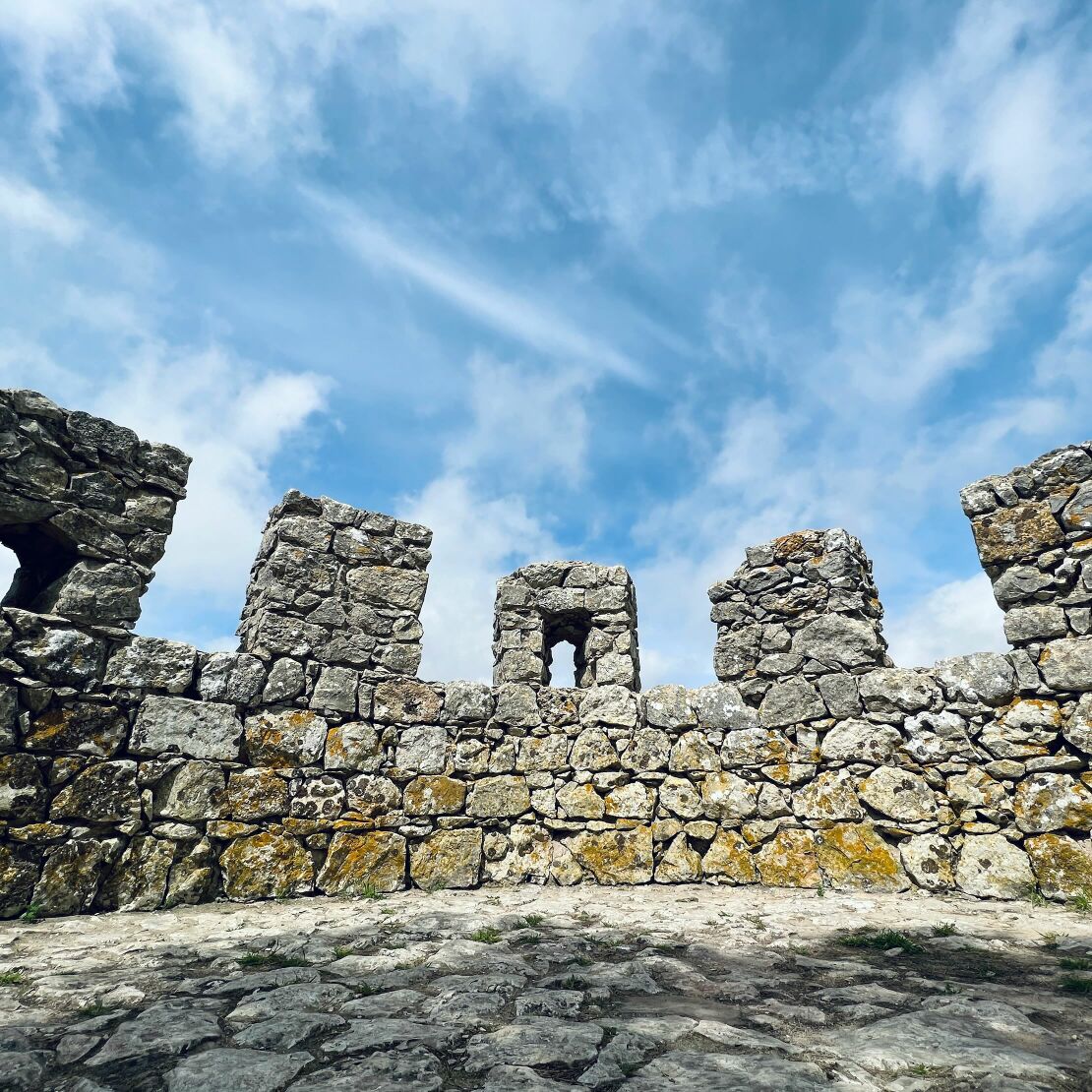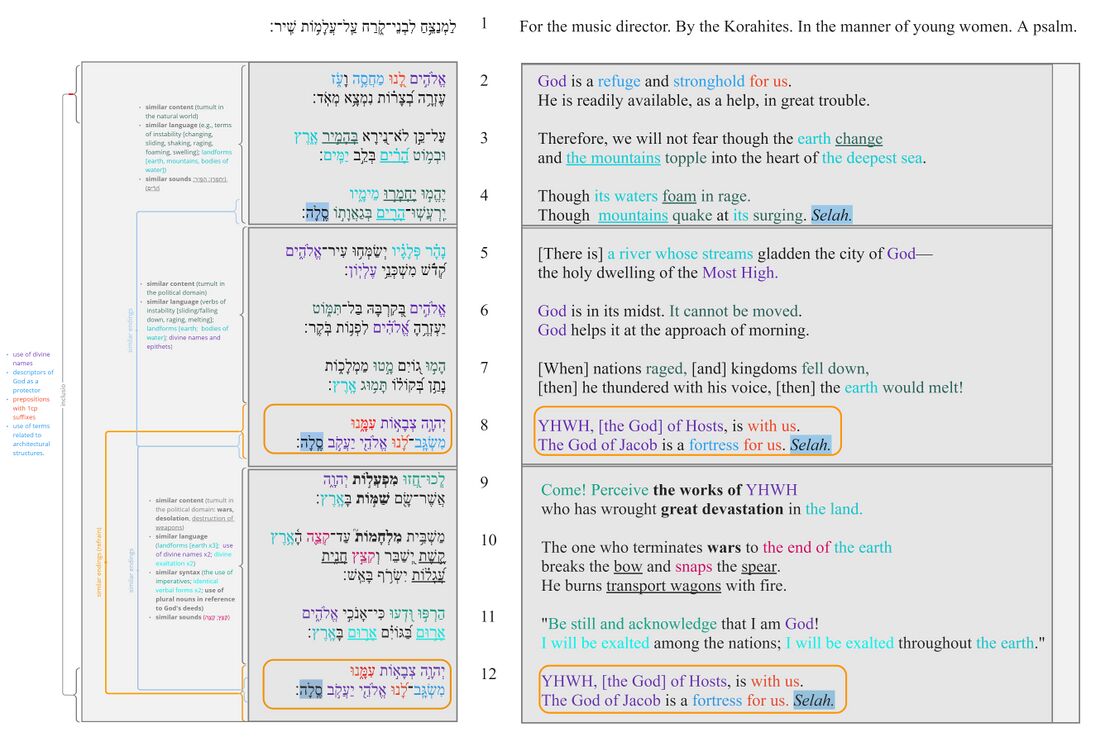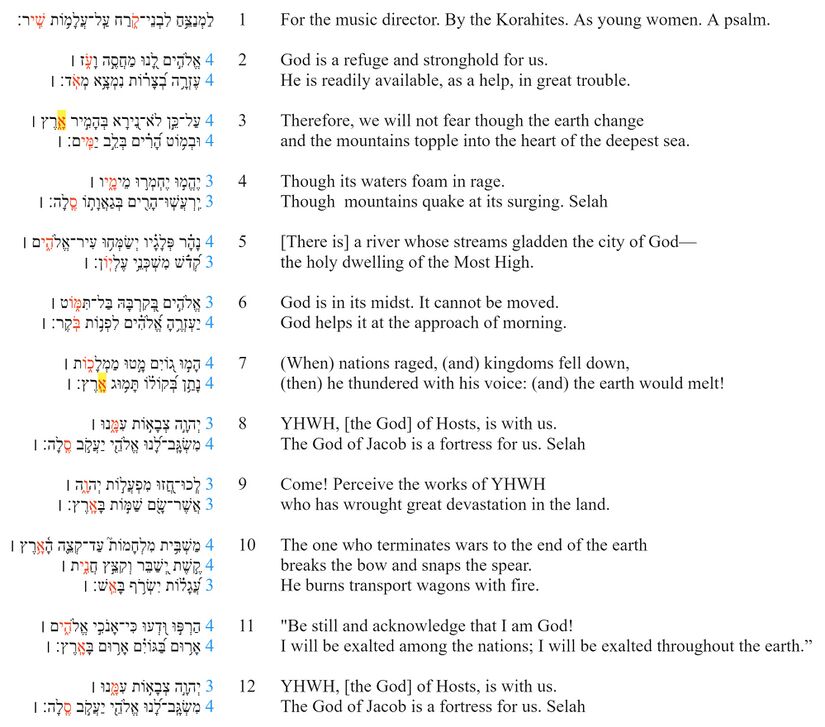Psalm 46 Poetic Structure
Poetic Structure
In poetic structure, we analyse the structure of the psalm beginning at the most basic level of the structure: the line (also known as the “colon” or “hemistich”). Then, based on the perception of patterned similarities (and on the assumption that the whole psalm is structured hierarchically), we argue for the grouping of lines into verses, verses into sub-sections, sub-sections into larger sections, etc. Because patterned similarities might be of various kinds (syntactic, semantic, pragmatic, sonic) the analysis of poetic structure draws on all of the previous layers (especially the Discourse layer).
Poetic Macro-structure
If an emendation or revocalization is preferred, that emendation or revocalization will be marked in the Hebrew text of all the visuals.
| Emendations/Revocalizations legend | |
|---|---|
| *Emended text* | Emended text, text in which the consonants differ from the consonants of the Masoretic text, is indicated by blue asterisks on either side of the emendation. |
| *Revocalized text* | Revocalized text, text in which only the vowels differ from the vowels of the Masoretic text, is indicated by purple asterisks on either side of the revocalization. |
| v. 1 For the music director. By the Korahites. As young women. A psalm. | Superscription | |||
| v. 2 God is a refuge and stronghold for us. He is readily available, as a help, in great trouble. | Stronger than Chaos | Chaotic forces cause the earth and mountains to shake and threaten the city of God. | anxious, yet confident | |
| v. 3 Therefore, we will not fear though the earth change and the mountains topple into the heart of the deepest sea. | ||||
| v. 4 Though its waters foam in rage. Though mountains quake at its surging. Selah. | ||||
| v. 5 [There is] a river whose streams gladden the city of God—the holy dwelling of the Most High. | Stronger than Nations | God supports the city so it is not shaken, even when the nations rage and kingdoms are shaken. | secure | |
| v. 6 God is in its midst. It cannot be moved. God helps it at the approach of morning. | ||||
| v. 7 [When] nations raged, [and] kingdoms fell down, [then] he thundered with his voice, [then] the earth would melt! | ||||
| v. 8 YHWH, [the God] of Hosts, is with us. The God of Jacob is a fortress for us. Selah. | As a fortress, God shelters his people from all threat. | |||
| v. 9 Come! Perceive the works of YHWH who has wrought great devastation in the land. | Stronger than All | God devastates the earth and is exalted among the nations. | confident & reverent | |
| v. 10 The one who terminates wars to the end of the earth breaks the bow and snaps the spear. He burns transport wagons with fire. | ||||
| v. 11 Be still and acknowledge that I am God! I will be exalted among the nations; I will be exalted throughout the earth.” | As a fortress, God shelters his people from all threat. | |||
| v. 12 YHWH, [the God] of Hosts, is with us. The God of Jacob is a fortress for us. Selah. | ||||
Notes
The psalm can be divided into three major parts (vv. 2–4, vv. 5–7, and vv. 9–11). After strophes 2 and 3, there is a refrain (vv. 8 and 12 respectively).[1] The three strophes are roughly equal in length, and the word Selah (rendered in the LXX as διαψαλμα [i.e., "interlude"]) finishes each section.[2] Furthermore, the psalm is framed by an inclusio: its opening and concluding sections contain divine names ("God/Elohim", "YHWH, [the God] of Hosts", and "the God of Jacob"), and descriptors of God as a protector of his people ("refuge", "stronghold", "fortress"). In strophe 1, vv. 2–4 are bound together by:
- Similarity in content (tumult in the natural world)
- Similarity in language
- Terms of instability (e.g., changing, sliding, shaking, raging, foaming, swelling)
- Terms signifying landforms (e.g., "earth", "mountains", and bodies of water)
- Similarity in sound (יחמרו ;הרים ;המיר)
- Similarity in number of lines (2 lines)
- Similarity in length of lines (4 lines of 4 prosodic words each and 2 lines of 3 prosodic words)[3]
The strophe finishes with a Selah.
In strophe 2, vv. 5–7 are bound together by:
- Similarity in content (tumult in the political domain)
- Similarity in language
- Terms of instability (e.g., toppling, raging, melting)
- Terms signifying landforms (e.g., "earth" and bodies of water)
- Terms signifying divine names and epithets
- Similarity in number of lines (2 lines)
- Similarity in length of lines (4 lines of 4 prosodic words each and 2 lines of 3 prosodic words).[4]
Similar connections exist between the strophe (vv. 5–7) and the refrain that follows it (v. 8). Namely:
- Similarity in content (divine protection; warfare)
- Similarity in language
- The use of divine names and epithets
- References to architectural structures
- Similarity in number of lines (2 lines)
- Similarity in length of lines (lines of 3 and 4 prosodic words).
Notably, the refrain (v. 8) finishes with a Selah.
In strophe 3, vv. 9–11 are linked by:
- Similarity in content
- Tumult in the political domain (wars, desolation, and destruction of weapons)
- Similarity in language
- Terms signifying landforms ("earth" x3)
- The use of divine names (x2)
- Statements about divine exaltation (x2)
- Similarity in syntax
- The use of imperatives
- Identical verbal forms (x2)
- The use of plural nouns in reference to God's deeds
- Similarity in sound (קצה; קצץ)
- Similarity in number of lines (2 sets of 2 lines and 1 set of 3 lines)
- Similarity in length of lines (4 lines of 4 prosodic words each and 3 lines of 3 prosodic words).[5]
Similar connections can also be identified between the strophe (vv. 9–11) and the refrain that follows it (v. 12):
- Similarity in content (divine protection; warfare)
- Similarity in language
- The use of divine names and epithets
- References to architectural structures
- Similarity in number of lines (2 lines)
- Similarity in length of lines (lines of 3 and 4 prosodic words).
As before, the refrain (v. 12) finishes with a Selah.
Line Divisions
Line division divides the poem into lines and line groupings. We determine line divisions based on a combination of external evidence (Masoretic accents, pausal forms, manuscripts) and internal evidence (syntax, prosodic word counting and patterned relation to other lines). Moreover, we indicate line-groupings by using additional spacing.
When line divisions are uncertain, we consult some of the many psalms manuscripts which lay out the text in lines. Then, if a division attested in one of these manuscripts/versions influences our decision to divide the text at a certain point, we place a green symbol (G, DSS, or MT) to the left of the line in question.
| Poetic line division legend | |
|---|---|
| Pausal form | Pausal forms are highlighted in yellow. |
| Accent which typically corresponds to line division | Accents which typically correspond to line divisions are indicated by red text. |
| | | Clause boundaries are indicated by a light gray vertical line in between clauses. |
| G | Line divisions that follow Greek manuscripts are indicated by a bold green G. |
| DSS | Line divisions that follow the Dead Sea Scrolls are indicated by a bold green DSS. |
| M | Line divisions that follow Masoretic manuscripts are indicated by a bold green M. |
| Number of prosodic words | The number of prosodic words are indicated in blue text. |
| Prosodic words greater than 5 | The number of prosodic words if greater than 5 is indicated by bold blue text. |
If an emendation or revocalization is preferred, that emendation or revocalization will be marked in the Hebrew text of all the visuals.
| Emendations/Revocalizations legend | |
|---|---|
| *Emended text* | Emended text, text in which the consonants differ from the consonants of the Masoretic text, is indicated by blue asterisks on either side of the emendation. |
| *Revocalized text* | Revocalized text, text in which only the vowels differ from the vowels of the Masoretic text, is indicated by purple asterisks on either side of the revocalization. |
Notes
- There are three strophes in Psalm 46 (vv. 2–4, 5–7 and 9–11), plus a refrain ("YHWH [the God of] Hosts is with us; the God of Jacob is a fortress for us") following the second and third strophes (vv. 8 and 12 respectively). Since the 19th century, scholars have suggested inserting the refrain after the first strophe as well (vv. 2–4; note the presence of a Selah after v. 4).[6] But the arguments in favor of inserting the refrain are purely internal (i.e., the presence of Selah after each strophe). There is no external textual support for such insertion. No manuscripts or versions support the inclusion of the refrain after v. 4. On the other hand, scholars observe that the omitted refrain could be a rhetorical tool to draw the reader's attention (past vv. 2-4) to the second strophe and its discussion of the city of God. Furthermore, van der Lugt argues that adding the refrain would disrupt the global level of symmetry in Psalm 46.[7] He notes that “the rhetorical structure of Psalm 46 is for positioning of verbal repetitions at exactly corresponding spots in the text." [8] So, recent structural analyses of Psalm 46 argue in support of the MT, i.e., against the addition of the refrain after v. 4.
- In v. 10, the MT has מַשְׁבִּ֥ית מִלְחָמוֹת֮ עַד־קְצֵ֪ה הָ֫אָ֥רֶץ קֶ֣שֶׁת יְ֭שַׁבֵּר וְקִצֵּ֣ץ חֲנִ֑ית עֲ֝גָל֗וֹת יִשְׂרֹ֥ף בָּאֵֽשׁ. Some scholars take the participle מַשְׁבִּ֥ית as introducing an asyndetic relative clause, i.e., “[the] one who causes wars to cease" or "stopping/terminating wars" unto the end of the earth. Others understand it as introducing a new, independent sentence ("He makes wars cease, etc.").[9] Although both options are viable, the participle מַשְׁבִּ֥ית should be taken as a substantive, i.e., “[the] one who terminates wars to the end of the earth". As such, it serves as the subject of the two yiqtols in v. 10bc. V. 9 starts with 2 imperatives ("Come! See [the works of the Lord]!"), and what is to be seen is communicated in v. 10. "The one who terminates wars" (10a) indicates a general description of God's acts. This is then followed by v. 10b, which focuses on the specific acts of destruction (i.e., breaking and burning implements of war). Furthermore, vv. 8-12 are marked by a series of concentric features, and within this section v. 10 is "pivotal."[10] "The double imperatives (lkw h.zw and hrpw wd‘w respectively), exactly at the beginning of the outer verselines (vv. 9 and 11), and b’rs (‘on earth’) exactly at the end of these lines deserve special mentioning."[11] Again, within these frames, v. 10 (describing general and specific acts of God) could be emphatic. Note, also that van der Lugt sees v. 10 as "standing out in the strophe [and also in the entire poem] because it is a tricolon." Note also that some suggest deleting v. 10c (i.e., the clause dealing with the burning of wagons) altogether. Thus, "An additional line has been added by a later editor to emphasise this destruction, but at the expense of the measure and symmetry of Str., Wagons He burneth in the fire".[12]
- ↑ Cf. Fokkelman's division (2000: 158–60): 2–4, 5–7.8| 9–11.12 [3.3.1|3.1 lines]; Weber (2001): 2–4.refrain(?)| 5–7.8|9–11.12; Gunkel (1926): 2–4+refrain, 5–8, 9–12; Duhm (1922): 2–4+refrain, 5–8, 9a+10–12.
- ↑ Cf. "Six-line stanza [Selah]; Six-line stanza, Chorus [Selah]; Six-line stanza. Chorus [Selah]" (Jacobson 2020, 314-315).
- ↑ Other notable features include: a.) repetition of the preposition ב (vv. 2b, 3a+b [2×], 4b); b.) alliteration due to the repeated הרים (vv. 3b, 4b; see also בהמיר in v. 3a); and c.) alliteration and chiasmus due to ימים and מימיו (vv. 3b and 4a) (van der Lugt 2010: 46).
- ↑ Other notable features include a.) the suffix ו (vv. 5a, 7b); b.) the preposition ב (vv. 6a, 7b); c.) the root מוט (vv. 6a,7a) (van der Lugt 2010: 46).
- ↑ Other notable features include: a.) the use of imperatives (vv. 9a and 11a) exactly at the beginning of the lines, forming an inclusio; b.) the use of יהוה/אלהים (vv. 9a and 11a; inclusio; exactly linear); c.) alliteration formed by שם שמות and משבית (vv. 9b and 10a); d.) an inclusio formed by בארץ (vv. 9b.11b) exactly at the end of the lines; e.) more uses of ב (באש [v. 10c]; and בגוים [v. 11b]); (van der Lugt 2010: 46) and f.) similarity in sound with words in vv. 3–4: ארום (x2; v. 11) and בהמיר (v. 3a) and הרים (vv. 3b, 4b).
- ↑ Cf. Craigie (1983: 342), who states, "It is possible that the twice repeated refrain (vv. 8, 12) originally occurred also after v. 5 (cf. BHS, note)." Note that H. Bardtke (BHS Psalms editor) suggests including the refrain after v. 4, according to vv. 8 and 12. Cf. Kraus (1988: 458-459), who notes that “The selah at the end of v. 3 [4] and the psalm’s structure of three uniform strophes call for the insertion of the refrain here [in v. 3] (cf. vv. 8 and 12).” See also, Gunkel (1903: 28) who says the refrain is needed for the sake of the symmetry of the strophes (cf. Briggs and Briggs 1906: 393; Anderson 1981: 355, 357; Weiser 1962: 65, 368-369; Raabe 1989: 52, 56, 59-60; see also, The Lutheran Book of Worship [1978]; The Book of Common Prayer [1977]). See, for example, the following suggestions on the structure of the Psalm: Weber [2001]: 2–4.refrain(?)| 5–7.8|9–11.12; Gunkel [1926]: 2–4+refrain, 5–8, 9–12; Duhm [1922]: 2–4+refrain, 5–8, 9a+10–12).
- ↑ van der Lugt 2010, 50.
- ↑ van der Lugt 2010, 51.
- ↑ E.g., "terminating wars to the end of the earth. He breaks the bow and snaps the spear, who burns chariots’ in fire" (Goldingay 2007: 67; cf. LSV; YLT; SLT; Douay-Rheims Bible; CPDV); "Who controls wars to the end of the world, who breaks bows and shatters lances, who burns chariots’ in fire" (Kraus 1988: 456). "He makes wars cease to the earth’s ends; he breaks the bow and shatters the spear, and burns war-wagons in the fire" (Craigie 1983: 343; most modern translation render v. 10a in a similar way); "canceling wars to the ends of the earth; he will shatter bow and break armor, and he will burn shields with fire" (LXX [NETS]; cf. Brenton Septuagint Translation).
- ↑ van der Lugt 2010: 50.
- ↑ van der Lugt 2010: 50.
- ↑ Briggs and Briggs 1906: 396, cf. 393. "This l.[ine] is trimeter and excessive to the Str. and is doubtless a gloss of intensification" (Ibid., 397).






